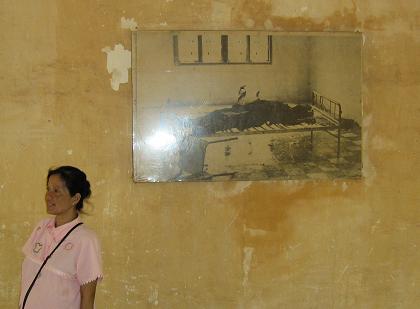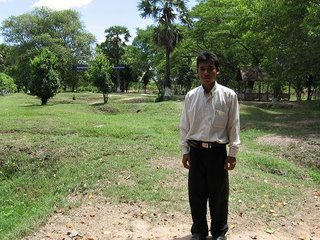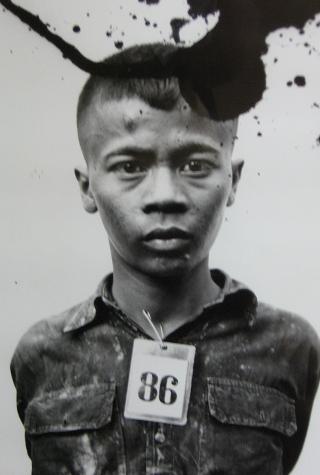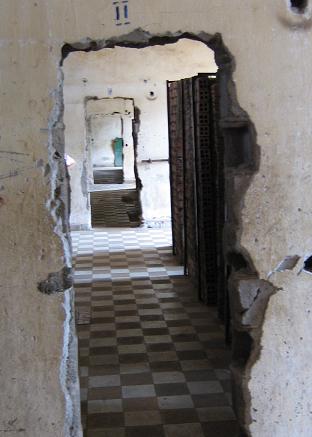Phnom Penh, Cambodia
I should warn you that this post and the photos following are disturbing. I'm afraid, there's nothing particularly hopeful about this set of notes, other than what I'm describing is over.
The military and imperial success of Thailand is very different from Cambodia, it is almost as if Thailand casts a shadow over it's neighbour, starving it of light or peace. Cambodia has endured a stunted growth or blighted existence and it's past contains one major ingredient. Conflict.
From the great Khmer empire, the Siamese invasion, French occupation, Japanese occupation, Vietnamese occupation, Monarchical dictatorship and the genocide of the Khmer Rouge regime, from my limited knowledge it appears Cambodia is country without much rest.
We wanted to learn more about the modern history of this country, having briefly been aquainted with the ancient capital of Angkor. Following independence from France in 1954, King Sihanouk took power of the new 'Kingdom of Cambodia' and retained it by contesting 'elections' and gaining 99% vote. He ruled with an iron hand, crushing communism where it threatened to mobilise. Despite this Sihanouk allowed the North Vietnamese to station Viet Cong guerillas in Cambodia, leading to American bombings. Unease and US bombings led to a coup, which deposed Sihanouk in 1970, but the replacement government was weak and the Vietnamese pushed further into the interior of the Kingdom. The communist elements - the 'Khmer Rouge' - organised themselves whilst a small clique within them plotted to blight the country with one of the worst regimes ever manisfested on earth.
The Khmer Rouge seized power in Phnom Penh on 17th April 1975. They were welcomed on the streets as liberating heroes, but within hours, the heart was being ripped out of the urban society, with all residents being forced to leave the city for a new agrarian life in the country. Pol Pot's brutal regime claimed the lives of almost half of Cambodia's 7 million population (in 1975) over the next four years. Paranoid, but utterly compassionless and clinical, the regime was firing on all cylinders from the word 'go'. All doctors, engineers, lawyers, intellectuals or indeed anyone with non-manual labouring 'soft hands' were rounded up to be totured at the prisons or murdered at the killing felds in the countryside. Oh... and if you happened to wear spectacles, you were considered an intellectual.
'S21' or Tuol Sleng, one prison of 167, and Choeung Ek, the largest killing field of 340 in Cambodia are both in Phnom Penh. These were our destinations today, and a raw, heinous shock to the system they proved.
As the Khmer Rouge rose prior to the coup on 17th April 1975, hundreds of children, both male and female between 14-18, were taken from their homes in the villages of the country to the jungle in the north of the country and brain-washed by Pol Pot's charges. These children were to become the combatants for the Khmer Rouge army. After marching into Phnom Penh, the redistribution of people into the countryside began, starting with movement into the established rural areas and in later weeks and months movement onwards to more remote areas. Troops over saw this mass movement of people, which was unheard of (I think) since Indian Partition. Thousands starved to death or died of diseases on the road travelling insane distances by foot. Those that survived were kept on their toes by the brutal Khmer Rouge soldiers.
The young KR combatants were also employed as prison guards, torturers and executioners in the prison camps, which extracted 'counter-revolutionary' information from officers of the previous government. They detained citizens until they were no longer useful, at which point they were disposed of at the killing fields.
Tuol Sleng was perhaps the most notorious of these prison camps. Four blocks of a school were comandeered and transformed into a rudimentary prison. Tuol Sleng ('poisonous hill' in English) was established in 1976. The large downstairs rooms were unmodified and used for the high ranking officials, to avoid conference with other prisoners. Other folk were held in tiny individual cells with barely room to more or in mass cells.
Comrade Duch presided over Security Office 21 and encouraged the dehumanisation of the guards to new levels of barbarity. The families of prisoners were also taken en masse to S21 to be held or executed, often in front of the prisoners. Baby's brains were dashed out on tree trunks or the infants were thrown up in the air and shot. Usually inmates were held between 2 to 4 months before being shipped to the killing fields. In the interim, the unfortunate inhabitants were kept weak; they were fed a bowl of rice porridge only twice a day at 8am and 8pm, in addition to torture, so they couldn't rebel or easily commit suicide. This had a side 'benefit' of making it easier for the still-developing adolescent captors to murder them. Among the horrendous torture methods were the following:
- Men were hung from an exercise pole in the former school yard until they lost consciousness. They were then revived in rank smelling water used for pesticide.
- Prisoners were suspended by their arms above drowning pools, so that when they could no longer support themselves, they would drown.
- Women were raped on a rack, endured their nipples being pierced by pliers, then suffered a scorpion or millipede being released over their body, which would bite and sting them.
Prisoners showered only twice a month and suffered terrible skin diseases. Aside from those who starved or murdered before reaching the killing fields, there were many instances of suicide and every attempt was made - fencing, constant observation etc. - to prevent this passage to relief.
We were shown around the prison by a lady of 38, who was 7 at the start of the Khmer Rouge regime. Her father, brother and sister were all killed. Despite conducting tours every day, I could see her body language change when she walked around the exhibitions of victim's mugshots and photos of dead bodies. I asked if she was OK, but she indicated that she was. This is her income, of course. She confided that she still cries everyday about what happened; how awful that she is confronted with this appalling grotto every day. I asked her if she held out hope for the future, but she said that one can still get in trouble for criticising the present government. While things have hugely improved with peace for the common man, freedom in western terms is still beyond reach.
As we were left to our own devices, wandering around the compund, you could see the barely disguised rage of the Kampuchean people in the gallery of Khmer Rouge leaders. Pol Pot - Prime Minister (a nick-name, short for 'political potential'), Son Sen - defence and security, Yun Yat - intelligence and information and Ke Puak - secretary of the northern zone, all had their pictures severely vandalised. Pol Pot's picture had been ripped clean off the wall.
After driving out to the killing field, Choeung Ek, the largest of this terrible phenomena, we took a new guide - this time someone from our own generation. This lad was more divorced from the situation; he was born in 1981 and therefore after the Rouge regime was over. His Uncle went missing but no-one else in his family, fortunate by Cambodian terms. It was interesting to hear how he had been effected growing up in the post-Khmer Rouge age.
Of the 20,000 people that were dispatched at Choeung Ek only 8,985 were exhumed from the mass graves. A permanent memoria charnal, or stupa, containing their skulls stands as a disturbing permanent reminder of the 'soft-hands' (non-labourers and hence potential political agitators) that died at the hands of child in a black shirt and red scarf. 500,000 people were ordered to leave Phnom Penh behind as a ghost town to work as a slave of Pol Pot's in the rice fields. Men, women and children were separated, working in different areas. They worked 15-16 hours for 2-3 bowls of rice porridge a day. Overwork leading to physical exhaustion was another rouse to keep the workers weak so they couldn't unite and overthrow their captors. Of those sent for execution at the killing fields not a single person escaped. You can see the foot shackles below, which would keep up to 30 men restrained in a line blind-folded awaiting their fate.
The fields had large holes or graves dug in them about 15-20 ft across, which you can see below. With the victims lined up in shackles, a Khmer Rouge combatant would kill one blind-folded victim by smashing him over the head with a bamboo truncheon (bullets were expensive) and pushing him into the hole, before moving on to the next - once a few were dead, the others would would topple in still alive from the weight beneath them. They were buried alive. The sound from an amplifier pumping out extraneous noise drownded out the sound of the screams. There were 86 mass graves found but a further 11,000 corpses lie undisturbed under a nearby lake. Any babies brought here would be killed in he same manner as at Tuol Sleng. Variations on the abominations committed were:
- Victim's throats slit with a palm leaf stalk
- Beheading for suspected traitors - Every day at Choeung Ek more innocent bones and clothes are washed up from the soil.
The net result of this regime was a halving of the population. A genocide.
Sosal, our guide, told us about life after Pol Pot, and he was optimistic about Cambodia's future. The Vietnamese toppled the Khmer Rouge regime in early 1979 and held the first meeting of a new assembly on May 20th, which is the date on which people remember the genocide annually. The secrets of the killing fields, unknown as a classified operation to the people, were discovered by farmers who smelt the stench of rotting human flesh. Once alerted, a full exhumation began in 1980 when the scale of the mass-murder became apparent.
The Khmer Rouge and Khmer Rouge guerillas were still abundant after the end of their rule, with a strong-hold in the northern jungle. Many ex-Rouge leaders found senior positions in the new government by defecting. Those that remained committed many terrorist acts the 80's and 90's disrupting the slightly improved governance of the country. The UN supported elections of 1993, began to see a more profound change in Cambodia, but it was not until 1996 when Pol Pot was found and arrested that the Khmer Rouge was truly defunct. The Angkar, or organisation, had ceased to exist.
Sosal felt he should have been taught about Pol Pot earlier than he age of 13 in school, but he still thought that understanding about the Khmer Rouge among his generation was improving. It's hard when a country wants to heal and forget, to be obliged to run over such painful ground. The Cambodian population has now shot up to 13 million. New life is great answer to all the death and destruction for an adult generation that could not escape the Khmer Rouge. It's also a reason to live.
In Cambodia the agrarian society Pol Pot forcibly created has not changed beyond recognition in 25 years, though it is fading. Sosal reckoned the requirement for both professionals and intellectuals was still high, but that changing children's aspirations from moto drivers to doctors was the key to a remedy. Our guide inside a cell at Tuol Sleng, or 'Security Office 21' as the Khmer Rouge called it.
Our guide inside a cell at Tuol Sleng, or 'Security Office 21' as the Khmer Rouge called it. 
Kosal, our guide at Choeng Ek, the dips in the ground are the mass graves.
 Ankle shackles at Choeung Ek. 30 men blind-folded would be led to the side of the mass graves and systematically beaten over the head with bamboo truncheon or machetes and pushed into the grave.
Ankle shackles at Choeung Ek. 30 men blind-folded would be led to the side of the mass graves and systematically beaten over the head with bamboo truncheon or machetes and pushed into the grave.
 Skulls of the victims of the Khmer Rouge, stacked in the Memorial Charnel at Choeung Ek.
Skulls of the victims of the Khmer Rouge, stacked in the Memorial Charnel at Choeung Ek.
 Photo of victim at Toul Sleng museum, it is stained with what I assume is blood.
Photo of victim at Toul Sleng museum, it is stained with what I assume is blood.
 Peering through the gates of hell. You can see the single cell constructions on the right hand side.
Peering through the gates of hell. You can see the single cell constructions on the right hand side.
 A better view of the individual cells. 2 bowls of rice a day, 2 showers a month.
A better view of the individual cells. 2 bowls of rice a day, 2 showers a month.




























